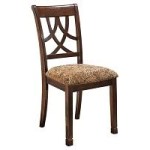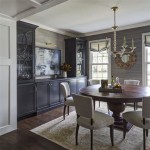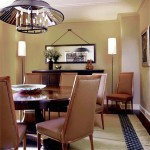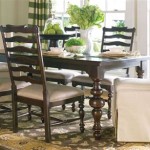Selecting the Ideal Chandelier for a Long Dining Room Table
The dining room serves as a central gathering space in many homes, often the location for shared meals, conversations, and celebrations. The selection of appropriate lighting is crucial in establishing the desired ambiance and functionality of this space. In the context of a long dining room table, a chandelier can serve as both a functional light source and a striking design element, unifying the length of the table and enhancing the overall aesthetic of the room. Careful consideration should be given to various factors when selecting a chandelier, ensuring that it complements the table's dimensions, the room's style, and the intended purpose of the space.
The selection process involves evaluating the size and shape of the table, the height of the ceiling, the existing décor, and the desired level of illumination. Overlooking these aspects can lead to a chandelier that feels disproportionate, provides inadequate or excessive lighting, or clashes with the overall design scheme. This article will delve into the key considerations for choosing a chandelier for a long dining room table, providing guidance on size, style, lighting, and installation.
Determining the Appropriate Size and Scale
One of the most important factors to consider is the size of the chandelier relative to the dining room table. A chandelier that is too small will appear insignificant and fail to provide adequate illumination, while one that is too large will overwhelm the space and create an unbalanced aesthetic. A general guideline is to consider the length and width of the dining table. Add these dimensions in feet, and the result equals the ideal diameter of the chandelier in inches. For instance, a table that is 8 feet long and 4 feet wide would ideally suit a chandelier with a diameter of approximately 12 inches.
For a long dining room table, it might be more appropriate to consider a linear chandelier, which extends along the length of the table. In this case, the length of the chandelier should be approximately two-thirds to three-quarters the length of the table. This ensures that the light is evenly distributed across the surface and that the fixture complements the table's proportions. If the table is particularly long, it might be necessary to consider two smaller chandeliers instead of one large one, spacing them evenly along the table's length to achieve balanced illumination and visual appeal.
Ceiling height is another crucial determinant of chandelier size. In a room with standard 8-foot ceilings, the bottom of the chandelier should hang approximately 30-36 inches above the table. For higher ceilings, the chandelier can hang lower, typically adding an additional 3 inches for each additional foot of ceiling height. Ensuring adequate headroom is essential for comfortable movement around the table. The goal is to create a visual focal point without obstructing views or creating a risk of accidental contact.
Beyond diameter and length, the height of the chandelier is also important, especially in rooms with lower ceilings. If the chandelier is too tall, it can dominate the space and create a sense of claustrophobia. Conversely, if it is too short, it may seem insignificant. It is generally recommended to err on the side of a shorter chandelier, especially in a room with limited ceiling height. This helps to maintain a sense of openness and prevents the fixture from feeling intrusive. Consider the overall volume of the room and the visual impact of the chandelier when determining the optimal height.
Choosing the Right Style to Complement the Room's Décor
The style of the chandelier should complement the overall design aesthetic of the dining room. Whether the room is decorated in a traditional, modern, contemporary, or rustic style, the chandelier should enhance and reinforce the existing décor. Opting for a chandelier that clashes with the room's style can detract from the overall cohesiveness and create a jarring visual effect. A traditional dining room might benefit from a chandelier with ornate details, crystal accents, and a classic silhouette. Conversely, a modern dining room might be better suited to a sleek, minimalist chandelier with clean lines and a simple geometric design.
In a contemporary dining room, a chandelier with a unique and artistic design can serve as a statement piece, adding personality and visual interest to the space. Experiment with different materials, shapes, and finishes to find a chandelier that reflects the room's modern sensibility. A rustic dining room can benefit a more natural, organic chandelier, perhaps featuring wood, metal, or fabric elements. The use of warm, earthy tones can enhance the rustic ambiance of the room. Consider the existing color palette, furniture styles, and architectural details when selecting a chandelier, ensuring that it integrates seamlessly into the overall design scheme.
It is also important to consider the scale and proportion of the chandelier relative to the other elements in the room. A large, ornate chandelier might overwhelm a small dining room, while a small, simple chandelier might get lost in a large, grand dining room. Striking a balance between the chandelier's size, style, and visual impact is essential for creating a harmonious and balanced aesthetic. Consider the existing furniture, artwork, and accessories when making your selection, ensuring that the chandelier complements these elements without overpowering them.
Selecting a chandelier finish that coordinates with other metal accents in the room is another key consideration. If the dining room features brushed nickel hardware, consider a chandelier with a similar finish to create a cohesive look. Likewise, if the room features brass accents, a brass chandelier can enhance the room's warmth and elegance. Mixing metal finishes can be done effectively, but it requires careful consideration of the overall design scheme. In general, it is best to stick to one or two dominant metal finishes to avoid creating a cluttered or disjointed look.
Selecting the Appropriate Lighting and Functionality
Beyond aesthetics, the primary function of a chandelier is to provide adequate illumination for the dining room. The type of lighting needed will depend on the intended use of the space. For formal dining rooms, where ambiance is prioritized, a chandelier with dimmable lights can create a soft, romantic atmosphere. For casual dining rooms, where functionality is more important, brighter, more direct lighting may be preferred. It is important to consider the number of light bulbs, the wattage of each bulb, and the type of light emitted when selecting a chandelier.
Warm white light is generally recommended for dining rooms, as it creates a welcoming and inviting atmosphere. Cool white light, on the other hand, can feel sterile and harsh, making it less suitable for dining. Consider using LED bulbs, which are energy-efficient and long-lasting. LED bulbs are available in a variety of color temperatures, allowing to customize the lighting to the desired ambiance. Dimmable LED bulbs provide even greater flexibility, allowing to adjust the light level to suit different occasions and moods.
The type of chandelier shade or diffuser can also affect the quality of light emitted. Shades made of fabric or glass can soften the light and reduce glare, while shades made of metal can direct the light downwards, creating a more focused and dramatic effect. Consider the shape and material of the shades when selecting a chandelier, ensuring that they complement the room's style and provide the desired level of illumination. Some chandeliers feature upward-facing lights, which create a soft, ambient glow. Others feature downward-facing lights, which provide more direct illumination for the table.
In addition to the chandelier, consider incorporating other light sources into the dining room, such as recessed lighting, sconces, or table lamps. Layering light sources can create a more dynamic and versatile lighting scheme, allowing to adjust the light level to suit different activities and moods. Recessed lighting can provide general ambient light, while sconces can add decorative accents and supplementary illumination. Table lamps can provide task lighting for reading or other activities. By combining different light sources, a well-lit and inviting dining room can be achieved.
Finally, consider the ease of cleaning and maintenance when selecting a chandelier. Chandeliers with intricate details and delicate materials can be difficult to clean, which may impact their long-term appearance. Opt for a chandelier that is easy to dust and wipe down, or consider hiring a professional cleaning service to maintain it regularly. Replacing light bulbs can also be a challenge with some chandeliers, so consider the accessibility of the bulbs when making your selection. By choosing a chandelier that is both beautiful and practical, a lasting investment in the dining room can be ensured.

Dining Room Lighting Chandelier Gingko 700 For Hospitality

20 Dining Rooms With Chic Chandeliers And Pendant Lights

Rectangular Crystal Raindrop Chandelier For Dining Room Sofary Lighting

Natural Marble Crystal Dining Room Chandelier

25 Of The Best Farmhouse Dining Room Lighting Ideas Lightopia

How To Hang A Chandelier At The Perfect Height Over Dining Table Mod Lighting

Pin Page

Dining Room Lighting Ideas For Every Style Pottery Barn

How To Choose The Perfect Dining Room Light Fixture Graham S Living

Dining Room Lighting Ideas And Inspiration From The Interior Design








